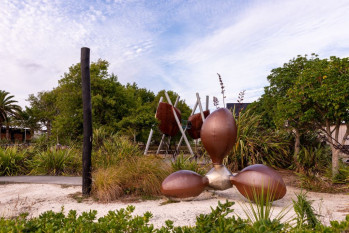Parks and amenities benefit residents and builders at Hobsonville Point
2 July 2020
Giving communities early access to amenities like parks, walkways and public artwork as part of new developments helps enhance wellbeing and land value overall, a new report on the Hobsonville Point development has found.
The report by Fresh Info, Understanding the relationship between social amenity, wellbeing and land values, was commissioned by Kāinga Ora – Homes and Communities to help inform future investment decisions across its portfolio of large-scale developments, with the goal of creating thriving communities. It surveyed more than 500 Hobsonville Point residents, builder and developer partners, and analysed residential land values at Hobsonville Point compared with other greenfields developments.
The report found residents place a high value on social amenity like parks, schools, walkways and public artwork, and by providing these at an early stage, builders and developers find it easier to market and sell homes. It also noted investment in social amenity at Hobsonville Point was linked to a rise in residential land values that was shared amongst homeowners, builders and Kāinga Ora.

Hobsonville Point park
Katja Lietz, Kāinga Ora Deputy Chief Executive of Urban Development Planning, welcomed the findings of the report. “Kāinga Ora understands, and has demonstrated, that the provision of social amenity is a pathway to creating thriving communities. Furthermore, by providing social amenity in our developments at an early stage, Kāinga Ora has created confidence with builders and developers,” Lietz says.
Peter Cooney, Director of Classic Builders, agrees. “Kāinga Ora’s early investment in social amenities like cafes, open spaces, parks, schools and ferry services, gave us, as developers, confidence and certainty around the future of this development. The Hobsonville Point development provided an exciting avenue for developing strong public-private collaborations, which can be replicated across other areas too,” Cooney says.
Dr Lee Beattie, Deputy Head of the School of Architecture and Planning at the University of Auckland, notes that the three most valued features were all parks and green spaces, highlighting the importance of thoughtful masterplanning of green space in medium density housing developments. “The report also indicates that even if they are not currently using the amenity, people value the option of using these features in the future, or simply knowing that they exist in the neighbourhood,” Dr Beattie says.
Lietz says the results achieved at Hobsonville Point will inform how Kāinga Ora approaches the masterplanning process and provision of amenity in other large-scale developments. “We understand that each neighbourhood we are working in has its own character, constraints and opportunities, and we’ll take all the relevant learnings from Hobsonville Point to set bespoke targets and measures on the benefits of social amenity across our developments,” Lietz says.
Media Contact
Page updated: 2 July 2020
